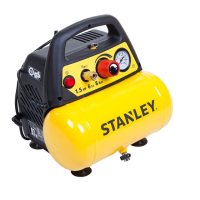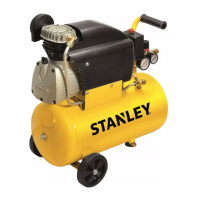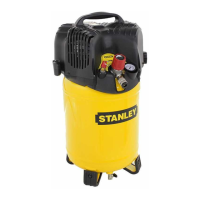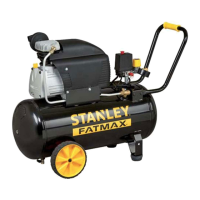8
USE OF THE COMPRESSOR
2
Connect the accessory required. Connect the compressor to the mains
using the power cable 10.
Press switch 1tostart the compressor.Thecompressor will continue to
operate until the air receiver is completely full. On reaching maximum
pressure (8 bar), the compressor will stop automatically. The pressure
value of the air contained in the receiver is indicated on gauge 3.
It is normal for the compressor to stop and restart at intervals during use
ofthecompressedair.
When you have finished using the compressor, switch off switch 1 and
disconnect the power cable 10fromthecurrentoutlet.Runtheaccessory
connecteddryuntilthereisnomoreairinthereceiver.
MAINTENANCE
3
Never clean the machine and its components with solvents, flammable or
toxicliquids.Usonlyadampclothmakingsureyouhaveunpluggedthe
compressorfromthecurrentoutlet.
After approx. 2 hours of use, the condensate that has formed must be
drainedfromthereceiver.Firstofall,ventalltheairusingtheaccessory
connected,asdescribedabove.Backoffventvalve5 located underneath
the compressor (switched off beforehand) by two turns, taking care to
maintainthecompressorinaverticalposition.Afterdrainingallthewater,
drawupthevalvetightly.
Warning: if the water that condenses is not drained, it may corrode the
receiver, reducing its capacity and impairing safety.
As it is a contaminating product, condensate must be DISPOSED of
in accordance with laws on protection of the environment and current
legislation.
The compressor must be disposed in conformity with the methods
provided for by local regulations.
Preserve this handbook for future reference
GB
Before using the compressor, read the instructions for use carefully
and comply with the following safety precautions. Consult this
handbook if you have any doubts regarding functioning
Preserve all the documentation so that anyone who uses the
compressor can consult this beforehand.
SAFETY RULES
1
This symbol indicates warnings to be read before using the product so as
to prevent injury to the user.
Compressed air is a potentially dangerous form of energy; always take
great care when using the compressor and its accessories.
Warning: the compressor may restart when power is restored following
a blackout.
An ACOUSTIC PRESSURE’s value of 4 m. corresponds to the
ACOUSTIC POWER’s value stated on the yellow label located on the
compressor, minus 20 dB.
DO’S
-Thecompressormustbeusedinasuitableenvironment(wellventilated
withanambienttemperatureofbetween+5°Cand+40°C)andneverin
placeswithdust,acids,vapors,explosiveorflammablegases.
-Keeptheworkareafree.Whenoperating,thecompressormustbeplaced
onastablesurface.
-Safetygogglesshouldbewornwhenusingthecompressorinorderto
protecttheeyesagainstanyforeignbodiesliftedbythejetofair.
-Ifpossible,whenusingair-poweredaccessories,wearsafetyclothing.
-Always maintain a safety distance of at least 4 meters between the
compressorandtheworkarea.
-Checkforcorrespondencebetweenthecompressorplatedatawiththe
actualspecificationsoftheelectricalsystem.Avariationof±10%with
respectoftheratedvalueisallowed.
-Inserttheplugoftheelectricalcableinasocketofsuitableshape,voltage
andfrequencycomplyingwithcurrentregulations.
-Use extension cables with a maximum length of 5 meters and with a
cablecross-sectionofnotless than 1.5 mm
2
.Useofextensioncables
ofdifferentlength and cross-section and also ofadaptersandmultiple
socketsshouldbeavoided.
-Alwaysusethehandletomovethecompressor.
-Whenusingcompressedair,youmustknowandcomplywiththesafety
precautions to be adopted for each type of application (inflation, air-
powered tools, painting, washing with water-based detergents only,
clinching,etc.).
-Toavoidoverheatingoftheelectricmotor,thiscompressorisdesigned
for intermittent duty operation as indicated on the technical dataplate
(for example, S3-25 means 2.5 minutes On, 7.5 minutes OFF). In
case of overheating, the thermal cutout of the motor is released,
automatically cutting off the power when the temperature is too high due
toexcesscurrenttake-off.Themotorrestartsautomaticallywhennormal
temperatureconditionsarerestored.
DON’TS
-Neverdirectthejetofairtowardspersons,animalsoryourbody.
-Neverletthe compressorcomeintocontactwithwaterorotherliquids
and never direct the jet of liquids sprayed by tools connected to the
compressor towards the compressor: as the appliance is live, this could
causeelectrocutionorshort-circuits.
-Neverusetheappliancewithbarefeetorwethandsorfeet.
-Neveryankthepowercabletodisconnecttheplugfromthepoweroutlet
ortomovethecompressor.
-Neverleavetheapplianceexposedtoadverseweatherconditions(rain,
sun,fog,snow).
-If this compressor is used outdoors, always remember to stow it after use
in a covered or closed place
-Neverusethecompressoroutdoorsinrainorbadweather.
-Never allow inexpert persons to use the compressor without suitable
surveillance.Keepanimalsatadistancefromtheworkarea.
-Thisapplianceisnotintendedforusebypersons(includingchildren)with
reduced physical, sensory or mental capabilities, or lack of experience
and knowledge, unless they have been given supervision or instruction
concerning the use of the appliance by a person responsible for their
safety.
-Childrenshouldbesupervisedtoensurethattheydonotplaywiththe
appliance.
-Thecompressedairproducedbythecompressorcannotnotbeusedfor
pharmaceutical, food or medical purposes or to fill the air bottles of scuba
divers.
-Do not place flammable or nylon/fabric objects close to and/or on the
compressor.
-Donotcovertheairinletsonthecompressor.
-Do not open or tamper with any part of the compressor. Contact an
authorizedServiceCenter.
COMPONENTS (fig. A - B)
1 I/O switch 7
Operating pressure
adjustment knob
2 Safety valve 8 Tank
3 Air used pressure gauge 9 Accessory hook
4
Compressed air outlet with
quick coupler
10 Power cable
5
Receiver condensation
drainage tap
11 Carrying handle
12 Rubber foot
13 Cord rewind hooks
